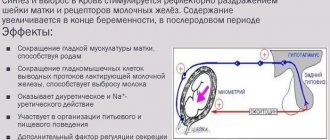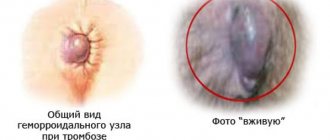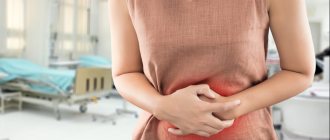Acute abdominal pain (the surgical term is “acute abdomen”) requires immediate hospitalization. Although there are several conditions that cause acute pain, they all require emergency treatment, which is where the term comes from.
According to the French surgeon Henri Mondor: “...The prognosis (for acute abdomen) is directly dependent on how quickly emergency medical care is called and provided.”
It is important to understand how dangerous an acute abdomen is, not to try to cope with the problem on your own and not to delay hospitalization. The risk of death with a delay of 1 day increases several times.
Causes
Signs of an acute abdomen may occur with the following diseases and conditions:
- damage to the abdominal organs as a result of closed abdominal injuries or penetrating wounds with damage to hollow organs (stomach, intestines);
- inflammation of the appendix (appendicitis), gallbladder (cholecystitis), pancreas (pancreatitis), ovaries and fallopian tubes (salpingoophoritis) and other organs;
- perforation (formation of a through wall defect) resulting from ulcerative lesions, tumors, foreign bodies or other reasons;
- bleeding, for example, during termination of an ectopic pregnancy and rupture of the fallopian tube;
- intestinal obstruction due to intestinal tumor and other conditions;
- cessation of blood supply, for example, thrombosis of mesenteric vessels with the development of intestinal infarction, torsion of an ovarian cyst.
About diagnosing appendicitis in Russia
Appendicitis is inflammation of the appendix of the rectum. For its initial diagnosis, confirmation or refutation of the diagnosis, doctors in Russia use certain symptoms of peritoneal irritation that have been proven over the years. There are few of them, but they are the reliable “old-timers” in clinical practice. Named after the surname of their author:
- Sitkovsky's symptom.
- Kocher's sign.
- Voskresensky's symptom.
- Obraztsov's symptom.
- Rovsing's sign.
- Shchetkin-Blumberg symptom.
The manifestation of each of them depends on a number of factors: the location of the appendix, the cause of inflammation, the advanced stage of the disease, etc. Let's analyze Sitkovsky's symptom and others in more detail.
Symptoms
The main signs that help make a diagnosis:
- abdominal pain, sometimes very severe;
- vomit;
- in some cases hiccups;
- lack of stool;
- bloating and lack of gas production;
- change in stool.
The pain can come on suddenly and be very severe right away. It is sometimes compared to being stabbed in the stomach with a knife. In other cases, it appears gradually, but within a few hours it intensifies significantly, accompanied by a deterioration in the general condition. The pain may intensify when the patient tries to lie down (this happens when a hollow organ is perforated). It may be absent during bleeding, but in this case an admixture of blood appears in the vomit or intestinal contents.
The remaining symptoms are most pronounced with intestinal obstruction. In other cases, they appear weaker or absent.
The patient or his relatives are briefly asked about the presence of abdominal pain in the past, about the diseases he has, about the operations he has undergone.
Pay attention to the patient's behavior: he may be agitated, rush about in severe pain (with intestinal obstruction) or lie motionless (with developed peritonitis). The patient's tongue is dry and has a gray coating visible on it.
There is an increase in heart rate, only in some cases it is slowed down. With internal bleeding, blood pressure decreases, the patient's skin turns pale, and cold sweat appears. Palpation (palpation) of the abdominal wall should be superficial and indicative. It causes pain throughout the abdomen or in specific areas.
The so-called symptoms of peritoneal irritation are important in the diagnosis of acute abdomen:
- symptom of muscle protection: tension of the abdominal muscles, general or in individual areas, sometimes reaching high intensity;
- Shchetkin-Blumberg symptom: when the hand is sharply withdrawn from the abdominal wall, a sudden increase in pain is noted.
These signs are especially pronounced in case of perforation (perforation) or damage, as well as in acute inflammation of the abdominal organs.
Percussion (tapping) of the abdominal wall can reveal the disappearance of hepatic dullness. Normally, the percussion sound in the lower parts of the chest on the right is dull and differs from the pulmonary sound on the left. When air enters the abdominal cavity, the peritoneum rises, and liver dullness disappears.
A sign of intra-abdominal bleeding is dullness of percussion sound in sloping areas of the abdomen, for example, in its lateral sections when the patient is lying on his back. Blood accumulates there, changing the nature of the sound during percussion.
A rectal examination is required to detect distended intestinal loops, tumors, blood or traces of black feces on the glove. This examination is especially informative in children. In women, a vaginal examination is necessary.
The conclusion about the presence of “acute abdomen” syndrome is usually made when there is a combination of acute pain and at least one of the following signs:
- symptoms of peritoneal irritation;
- bloating;
- compaction in the abdominal cavity.
If a doctor or other medical professional discovers these signs, he must suspect a diagnosis of acute abdomen and immediately hospitalize the patient in the surgical department of the hospital. If you experience abdominal pain, you should not take painkillers, antispasmodics, sleeping pills or other medications until examined by a doctor. They can temporarily reduce the severity of symptoms. This will lead to a delay in diagnosis and loss of precious time during which it is necessary to operate on the patient. Taking laxatives is very dangerous, often leading to the release of feces into the abdominal cavity.
Providing first aid to a patient with an acute abdomen
First aid for an acute abdomen should be provided immediately.
The first step is to call an ambulance, place the patient on the bed and open the window slightly to allow air to flow. First aid requires adherence to several important rules.
- You should not use painkillers and antispasmodics. This can lead to a blurred clinical picture and incorrect diagnosis.
- You cannot drink laxatives or do enemas. These processes in an acute abdomen can lead to the throwing of contents into the abdominal cavity.
- It is prohibited to eat or drink anything.
- Do not apply a hot heating pad to your stomach.
The only thing you can do is apply a cold compress to the abdominal area. But it is better to follow all the doctor’s recommendations, which can be transmitted over the phone before the ambulance arrives.
In the case of an “acute abdomen”, emergency care takes the patient to the clinic. In the meantime, the abdomen is palpated. The degree of tension in muscle structures, the location of pain, and the disappearance of hepatic dullness are determined.
The diagnosis will be made if an acute pain sensation is accompanied by a tense and irritated peritoneum and bloating.
For children with pain, a rectal examination is performed. Women have their vagina examined. This will help identify the presence of tumors, bloating in intestinal loops, and the appearance of black stool.
The emergency department then transfers the patient to surgery. There he undergoes an ultrasound and rectal examination. If the pulse is lost, the skin turns pale, and the body becomes covered in cold sweat, then this indicates the development of a serious condition of the patient. Then an operation is performed urgently.
Pseudoabdominal syndrome
Sometimes symptoms resembling an acute abdomen occur with other diseases. The so-called pseudo-abdominal syndrome develops, which can cause diagnostic errors.
Causes of false acute abdomen:
- diseases of the abdominal organs (exacerbation of peptic ulcer, enterocolitis, hepatitis and others);
- pleurisy, pneumonia;
- myocardial infarction;
- pathology of the urinary system (paranephritis, pyelonephritis, acute urinary retention, renal colic);
- changes in the nervous system (brain tumor, radiculitis, intercostal neuralgia);
- other pathological conditions (food poisoning, diabetes, rheumatism, endometriosis).
To exclude all these diseases, it is important to carefully collect anamnesis and examine the patient. Often with a false acute abdomen, pain and tension in the abdominal muscles are less pronounced. During observation, their intensity may change. To clarify the diagnosis, the patient is hospitalized in the surgical department, where additional diagnostics are performed. In case of abdominal pain, an electrocardiogram must be recorded and an x-ray of the lungs must be performed.
Treatment of pseudoabdominal syndrome is carried out conservatively. It is aimed at the disease that caused these symptoms.
Acute appendicitis during pregnancy
Inflammation of the appendix during pregnancy is not very common. The study showed that the risk of developing the disease is significantly reduced, especially in the third trimester. The displacement of the appendix, caused by the enlarged uterus, complicates the diagnosis of the disease. Very often, pain accompanying appendicitis is considered as the onset of labor.
The maternal mortality rate with a simple form of appendicitis is minimal, but the risk of rupture of the inflamed appendix increases by 4%. Fetal mortality rates are at 1.5% in uncomplicated forms and 20...35% in cases of rupture.
Forecast
The outcome of the disease depends on the following factors:
- nature of the disease;
- its heaviness;
- time from onset of illness to hospitalization;
- patient's age;
- presence of concomitant diseases.
Only the time to seek help depends on the patient and his relatives: the sooner the ambulance is called, the greater the chances of recovery. In addition, you should remember: before the doctor arrives, you should not eat, drink, or take medications, especially laxatives and painkillers.
Possible complications
Removal of an inflamed appendix is considered by doctors as a relatively safe operation. But the development of complications is still not excluded.
- Wound infection. The cause of the development of wound infection is the contamination of the wound with pathogenic microorganisms during the operation. The risk of complications reaches 5% in uncomplicated appendicitis and 20% in the case of appendicitis with perforation or its atypical forms.
- Intra-abdominal abscess. Suppuration in the pelvic cavity is caused by extensive infection, caused, for example, by a rupture of the appendix.
- Appendicular infiltrate. The seal forms by the third day from the onset of the disease. It is clearly palpable. It is the result of enveloping the inflamed appendix with intestinal loops or peritoneal tissue. The symptoms of appendicitis are blurred. The use of antibacterial agents makes it possible to avoid surgical intervention, but the risk of relapse is high.
- Appendiceal abscess. The occurrence of suppuration is indicated by the development of characteristic symptoms - high fever, leukocytosis (an increase in the number of leukocytes relative to the norm), tachycardia. The main area of localization is the iliac region. More rarely, suppuration is diagnosed in the pelvic cavity. To confirm, the patient is prescribed a rectal examination. Treatment is open surgery followed by installation of a drainage system.
- Chronic appendicitis. Chronicity of the disease occurs in 1% of all diagnosed cases. As a rule, it is caused by the formation of adhesions and scars, causing a narrowing of the lumen of the appendix, as well as by remnants of infection. During the period of remission, the clinical picture of the disease is absent. The treatment is elective appendectomy.
Which doctor should I contact?
If a person suddenly experiences acute pain in the abdomen, accompanied by tension in the muscles of the abdominal wall, nausea, vomiting, black stool or its absence, it is necessary to call an ambulance.
Treatment of acute abdomen is carried out by an abdominal surgeon, less often by a gynecologist.
Additionally, you may need to consult a urologist, cardiologist, pulmonologist, therapist, or neurologist. These specialists examine the patient already in the hospital.
Acute abdomen is a collective concept that unites many catastrophic situations localized in the abdominal cavity. The condition requires immediate diagnosis and emergency medical intervention, since this is the only way to save a person’s life. The syndrome develops regardless of age category.
The disorder can be caused by: any acute inflammatory process (for example, appendicitis), severe trauma to the peritoneum, impaired local circulation, intestinal obstruction of any nature.
The main clinical manifestation is pain, which is diffuse and sharp in nature. In addition to this symptom, nausea and vomiting, fever, heart rate disturbances, stool upset and many other symptoms may develop.
The diagnosis of acute abdomen can be made by a gastroenterologist only based on the results of laboratory and instrumental examinations. Primary diagnostic manipulations are of an auxiliary nature. At the clinic, you need to urgently seek medical help.
Elimination of the pathological condition consists only of surgical intervention. It is better if the operation is performed no more than 6 hours after the appearance of the first clinical signs.
According to the International Classification of Diseases, Tenth Revision, the syndrome has its own code. The ICD-10 code will be R10.0.
Clinical manifestations
The disease is characterized by rapid development of symptoms. This is especially true for the main manifestation – severe pain that occurs in paroxysms. The gradual development of signs of the disease with increasing intensity is observed in rare cases.
Causes of concern should be:
- Increase in body temperature.
- Lack of bowel movements due to impaired peristalsis.
- Severe bloating in the absence of other symptoms of flatulence.
- Long lasting hiccups.
- Pain in the abdominal area.
- Nausea and vomiting.
- Overstrain of the abdominal muscles.
- General malaise.
- Pallor of the skin.
- Presence of blood in stool or vomit.
When pain occurs, it is important to consider its location. The most severe attacks occur in cases of trauma or injury to the abdomen. In children, such manifestations, as a rule, are unexpressed. In most cases, the child cannot independently determine the location of the pain syndrome.
In a situation of severe pathological phenomena in the absence of first aid, the patient may exhibit symptoms of an acute abdomen in combination with a state of shock. Added to the clinical picture are lethargy and changes in skin color. In rare cases, the disease is hidden, as it is not accompanied by pronounced clinical manifestations.
Etiology
A large number of different conditions can cause a pathological condition, which are not always associated with the organs of the digestive system, but for help it is necessary to turn to a gastroenterologist.
The most common predisposing factors:
- inflammatory lesion of the cecum or acute appendicitis;
- intra-abdominal hemorrhage;
- ovarian apoplexy;
- tubal pregnancy;
- any abdominal injuries;
- intussusception;
- perforation of the genital organs.
Diseases
Most often, abdominal pain is caused by diseases of the intestines, stomach, pancreas, problems with the gallbladder, as well as hernias.
- Ulcerative colitis is a diffuse inflammation. The rectal mucosa is affected. In the initial forms of ulcerative colitis, inflammation affects only the proximal part (the entrance to the intestine); in advanced forms, the problems affect the entire colon. As the disease progresses and worsens, the patient feels a sharp deterioration in health, the body begins to become intoxicated, the pulse quickens, and in most cases blood appears in the stool. If the disease is not treated, the body can poison itself, and peritonitis can develop, a lesion of the abdominal cavity that poses a threat to life.
- Enteritis. The small intestine becomes inflamed. At first, the disease is “masked” as a disease, and often accompanies this problem. If the disease is not treated in a timely manner, the functions of the small intestine are disrupted. Food begins to be poorly absorbed by the intestinal walls. Digestion processes are disrupted.
- Crohn's disease. One or several areas of the intestine can become inflamed. But almost always the inflammation affects the junction of the large and small intestines. One of the most unpleasant aspects is that the inflammation affects the entire thickness of the wall, and a complication of the disease is intestinal obstruction syndrome, the treatment of which requires the adoption of a set of measures related to the simulation of motility and restoration of intestinal function.
- Dysbacteriosis is a disorder of the intestinal microflora. The number of beneficial bacteria in the intestines is reduced, and pathogenic microflora develops. As a result, gas formation occurs, a person cannot digest food, and bowel movements are disrupted. Very often, the development of dysbiosis is a consequence of incorrect antibiotic therapy or a reaction to stress.
- Pancreatitis. The most common disease affecting the pancreas is pancreatitis. When the pancreas is inflamed, a person feels severe discomfort in the upper abdomen, and it becomes difficult for the body to digest proteins and fats. Often in everyday life they say in this case: “There are not enough enzymes.” And this really reflects the real picture. In the affected pancreas, the production of lipase, chymotrypsin, and trypsin is significantly reduced.
- Cystic fibrosis is a disease that disrupts the functioning of the pancreas and respiratory system. It is a non-inflammatory pathology. The reason is hereditary factors. A complication of the disease may be the formation of a duodenal ulcer.
Stomach diseases
Some of the most common diseases that affect people of all ages are accompanied by abdominal pain - these are pathologies of the stomach, especially its mucous membrane. The leaders are gastritis, ulcers, gastroesophageal reflux disease.
- Gastritis. It is an inflammation of the gastric mucosa. The entire stomach or certain parts of it can become inflamed. With gastritis, pain with burning and spasms predominate. The patient is concerned about discomfort after eating, a feeling of a full stomach or, on the contrary, “sucking” and a constant feeling of hunger. Accompanying the disease in the acute stage are vomiting and nausea.
- Stomach ulcer. Pain occurs against the background of characteristic ulcerative lesions of the gastric mucosa. Dyspeptic symptoms are pronounced: heaviness in the stomach, a feeling of oversaturation of the stomach, pain in the epigastric region.
- Gastroesophageal reflux disease (popularly known as “reflux”). The disease is associated with a weakening of the valve between the stomach and esophagus. The result of this weakening is pain, accompanied by heartburn. Very often, gastroesophageal reflux disease appears in patients who have already experienced gastritis or a stomach ulcer.
Symptoms
The first and main symptom of an acute abdomen is pain of a pronounced nature. The location of pain may vary slightly. For example, if appendicitis occurs, the focus will be in the lower abdomen on the right, with liver damage - in the area of the right hypochondrium, with gastritis, girdle pain is noted. It is worth noting that with internal bleeding there may be no pain at all, but other symptoms characteristic of the malaise will be expressed.
Symptoms of an acute abdomen are as follows:
- prolonged hiccups;
- an increase in the size of the anterior wall of the abdominal cavity;
- complete absence of gas discharge;
- stool retention;
- nausea accompanied by prolonged vomiting - vomiting does not bring relief;
- change in the consistency and shade of feces;
- increased heart rate and pulse;
- increased body temperature;
- blood pressure fluctuations;
- pale skin;
- cold sweat;
- the presence of blood, mucus and pus in feces and vomit;
- dry mouth;
- coating of the tongue with a white or gray coating;
- abdominal muscle tension;
- increased urge to urinate;
- headaches, less often - dizziness;
- body aches;
- aversion to food;
- weakness and weakness or, conversely, increased excitability;
- irritability and sudden mood swings;
- sleep disturbance, up to its complete absence.
These are the main clinical manifestations of the syndrome, however, the symptomatic picture will necessarily be supplemented by symptoms characteristic of the etiology of the disease.
When the main signs appear, emergency assistance is necessary. You should call a team of doctors to your home, and then begin a series of actions. First aid for acute abdomen:
- provide the victim with a horizontal position;
- to ensure that the person does not choke on his own vomit;
- apply a cold compress to the stomach to reduce the severity of pain;
- ventilate the room.
You need to know what limitations emergency care has for an acute abdomen:
- Under no circumstances should you feed or give water to a sick person, even if the person asks strongly;
- It is forbidden to wrap up the victim or apply a heating pad to the stomach;
- It is not recommended to give cleansing enemas;
- It is strictly forbidden to take any medications, for example, laxatives, antibiotics, antiemetics or painkillers - the only exception is made in a situation where the arrival of an ambulance is delayed, and the transportation of the patient is allowed: taking antispasmodics or broad-spectrum antibacterial agents is allowed.
Urgent actions
An “acute” abdomen requires immediate medical attention. Therefore, the first correct action of eyewitnesses is to call an ambulance. During the conversation with the dispatcher, describe the patient's symptoms and behavior. If you are his relative, tell him about the presence of chronic diseases.
Before medical help arrives for an “acute” abdomen, follow these steps:
- Help the patient lie down in a way that is comfortable for him. You should not force him to change position if the pain intensifies.
- Calm down, explaining that doctors will arrive soon to help.
- Place a cold heating pad on your stomach. It can be replaced with an ice pack or frozen food from the freezer. However, you need to remember that in this case the package or products are wrapped in cotton cloth. Remember that every 10 minutes you need to remove the cold object from your skin for 5-6 minutes. Otherwise, tissue necrosis will occur.
- If the patient has lost consciousness, make sure that his head is turned to the side. This action is necessary to prevent the victim from choking on his vomit.
- In case of recorded cardiac arrest, resuscitation measures are indicated: artificial respiration and cardiac massage.
First aid begins to be provided in an ambulance. First of all, it is aimed at eliminating the manifestation of painful shock.
Remember!
Before the doctors arrive, it is prohibited to choose treatment tactics on your own!
Before hospitalization, the patient is prohibited from providing the following assistance:
- Give analgesics, antibiotics or other medications.
- Offer food and drink;
- Give enemas;
- Give a laxative;
- Warm your stomach.
After delivering the victim to the hospital, the need for emergency surgical intervention is determined. To correct violations of vital signs, the patient is intensively prepared for surgery for 2-3 hours. In emergency cases, surgery is performed immediately.
Inflammation of the appendix
Inflammation of the appendix is the most common cause of an “acute” abdomen. Despite the 100% success of operations to remove the appendix, mortality from this pathology occurs more often than with a perforated ulcer. This situation is caused by incorrect diagnosis, failure to provide emergency care on time and late hospitalization. All these factors lead to a dangerous complication – peritonitis.
Basically, the pathology begins suddenly against the background of general well-being. The pain is constant and increasing. They are localized in the umbilical region, then move to the right side of the abdomen. The pain syndrome may be accompanied by nausea and single vomiting.
When the first symptoms of appendicitis appear, you should immediately call an ambulance and apply cold to the painful area of the abdomen.
https://youtu.be/kBNo6GhvPiI
Diagnostics
An acute abdomen requires rapid diagnosis so that the patient can receive prompt surgical care. The following laboratory tests are carried out:
- general blood analysis;
- biochemistry of blood and urine;
- microscopic examination of vomit;
- coprogram;
- general clinical urine analysis.
Then they turn to instrumental procedures:
- radiography of the abdominal and thoracic cavity;
- Ultrasound of the peritoneum;
- ECG;
- CT;
- MRI;
- irrigoscopy;
- diagnostic laparoscopy.
How did the definition of disease come about?
This term is used in medicine to refer to acute pain that occurs in the abdominal cavity and requires immediate surgical attention.
Acute abdomen syndrome can be caused by obstruction of abdominal organs or gastrointestinal disease. This syndrome poses a real danger to the patient's life. The definition of “acute abdomen” syndrome appeared in medical practice after the publication of Henry Mondor’s book “Emergency Diagnosis. Belly", which was published in 1940. In the book, the surgeon mentioned a synonym - “abdominal catastrophe.” It was after this publication that medical practice began to discuss the diagnosis and treatment of a disease such as acute abdominal syndrome. Symptoms and causes began to be studied more thoroughly.
Henry Mondor was not the only surgeon to describe this disease. The Russian surgeon N. Samarin studied this condition, and in his books he claims that a patient with this syndrome should be taken to the hospital very quickly. In his publications, which were published several times, he states that after the first symptoms appear, the patient has only 6 hours.
Treatment
After confirmation of the diagnosis, the patient is sent to a specialized surgical department. When a false acute abdomen syndrome was discovered, the patient was transferred to the gastroenterology department.
Preoperative preparation is kept to a minimum - it consists of intravenous administration of antispasmodics and consultation with an anesthesiologist.
Treatment of an acute abdomen requires surgical intervention, but the choice of method of operation for the patient is carried out individually.
Where to go?
The doctors of the 5th Clinical Hospital have extensive experience in performing laparoscopic operations and hernioplasty in Minsk.
In addition to accepting patients who are citizens of Belarus, the 5th City Hospital of Minsk also accepts foreign citizens (on a paid basis). Each of them can undergo comprehensive diagnostics and treatment at the surgical and therapeutic departments.
The hospital has its own clinical diagnostic laboratory, X-ray department, X-ray CT and MRI rooms. The physiotherapy department has all the conditions for conducting rehabilitation programs.
Abdominal pain: is it dangerous?
How often do we experience abdominal pain? Sometimes it can simply be a consequence of overeating or the result of eating stale food. But it may also happen that pain serves as an alarm signal for the body. Unfortunately, we cannot always interpret it correctly.
Abdominal pain often occurs suddenly
Abdominal pain often occurs suddenly, at the most inopportune moments: when we are at the dacha, on the road, just relaxing in nature or working. It is important to understand when you need to seek medical help and when you can do it on your own.
How to help a patient
The following reasons can lead to the occurrence of the disease:
- Pancreatitis, cholecystitis, appendicitis, peritonitis, colon cancer, embolism, vascular thrombosis, abscesses.
- Ruptures or perforation of the stomach, intestines.
- Ruptures of the pancreas, spleen, liver, uterus, appendages, which may be accompanied by bleeding into the abdominal cavity.
- Intestinal obstruction.
- Disease of organs that are located outside the abdominal cavity.
Based on the above, there is a classification of the causes of this disease:
- Inflammatory diseases that require emergency surgery.
- Acute bleeding in the gastrointestinal tract (Mallory-Weiss syndrome, bleeding ulcer, anorectal bleeding, stomach tumor, hemorrhagic gastritis).
- Abdominal trauma or penetrating injury that damages the liver, spleen, intestines, or pancreas.
- Diseases of the gastrointestinal tract that do not require emergency surgical care (hepatitis, peritoneal carcinomatosis, gastroenteritis, yersiniosis, liver porphyria, hepatic colic, acute cholecystitis, pseudomembranous enterocolitis).
- Gynecological diseases (dysmenorrhea, painful syndrome in the middle of the menstrual cycle, salpingitis).
- Renal diseases (pyelonephritis, renal infarction, renal colic, paranephritis, hydronephrosis in the acute stage).
- Cardiovascular diseases (aortic aneurysm, myocardial infarction, pericarditis).
- Neurological diseases (intervertebral disc herniation, Schmorl's hernia).
- Pleuropulmonary (pulmonary embolism, pleurisy, pneumonia).
- Urogenital diseases (ovarian volvulus, acute urinary retention).
- Spinal cord injuries (trauma, myelitis), fractures of ribs, vertebrae.
- Other diseases (intoxication of the body due to arsenic, lead poisoning, uremic coma, leukemic crisis, diabetic coma, hemolytic crisis, Werlhof's disease).
First aid for acute abdominal syndrome is to immediately hospitalize the patient. Upon hospitalization, the patient should immediately be assigned to the surgical department.
Help with “acute abdomen” syndrome excludes painkillers. This applies to both narcotic and non-narcotic analgesics, which not only blur the clinical picture, but also complicate the diagnosis of the patient. In addition, drugs can worsen the patient’s condition, delay the timing of surgery, and can cause spasm of the sphincter of Oddi. It is also not allowed to use nootropic, psychotropic, laxatives, antibiotics, or give cleansing enemas.
Pain syndrome in children can be a symptom of a variety of diseases. Often this may be irritation of the mucous membrane, peritoneum, and not acute abdominal syndrome in children. The symptoms of this disease in children are the same as in adults. The source can be not only an organ located in the abdominal cavity.
Causes of abdominal pain in children:
- Dysbacteriosis.
- Inflammation of the esophagus.
- Colitis.
- Enteritis.
- Enterocolitis.
- Gastroduodenitis.
- Duodenitis.
- Gastritis.
- Stomach ulcer.
- Reflux esophagitis.
- Ulcerative colitis.
- Constipation.
- Pancreatitis.
- Cholecystitis.
- Hepatitis.
- Worms, lamblia, roundworms.
- Biliary dyskinesia.
- Intestinal infection.
- ARVI.
- Measles.
- Chickenpox.
- Cystitis.
- Pyelonephritis.
- Urolithiasis disease.
In any case, if a syndrome occurs - acute abdominal pain, even as a symptom of any of the above diseases, this is the first “bell” to seek help. It is believed that if a person is sufficiently educated and cultured, then he is able to identify the symptoms of a surgical disease in the acute stage.
This is often not the case. According to statistics, the cause of severe complications of appendicitis in the acute stage is the patient’s ignorance of the early manifestations of the disease. The unexpected absence of a painful syndrome is not a reason for joy, as it may indicate a rupture of the wall of the inflamed intestine. In many cases, when the patient is delivered late, the outcome of the surgical intervention depends on the skill of the doctor and postoperative treatment.
Acute abdomen syndrome is a frightening disease, especially for parents. Therefore, it is worth noting that before suspecting the worst, you need to know that a common cause of pain in children is appendicitis in the acute stage or an inflammatory process of the appendix of the cecum. It is important to know that with acute appendicitis in young children, the pain syndrome is mild.
How to distinguish appendicitis from poisoning or intestinal infection? Pain from appendicitis occurs in the upper or umbilical region, but not in the right iliac region (the place where the appendix is located). There are cases when in young children the appendix is located in the rectal area, near the bladder.
In such a case, only a surgeon with extensive experience can recognize ordinary appendicitis. Other accompanying symptoms (vomiting, nausea and fever) may not develop in some cases. In cases of severe gangrenous appendicitis, white blood cells may not be increased and abdominal muscle tension may be absent.
It is important to know that self-medication in children is unacceptable. Not only should pain syndrome not be joked about and pharmaceutical drugs thoughtlessly given to children, but a simple cold is also not something to joke about. Enemas, gastric lavage, taking sorbents or other drugs that may be prescribed for food poisoning, intoxication or intestinal obstruction can only aggravate acute appendicitis or possible acute abdominal syndrome.
It is worth calling an ambulance immediately, not to blur the picture before arrival and not to lead the doctors on a “false trail.” The child should not be given water or food. If the ambulance is delayed and the child gets worse, you can call the doctor so that he can advise on further actions. Also, if you have transport at home, you can take your child to the hospital emergency department.
acute inflammatory diseases (appendicitis, cholecystitis, pancreatitis),
perforation of hollow organs (stomach, intestines) or their ruptures,
ruptures of parenchymal organs (liver, spleen, pancreas, uterus and its appendages), accompanied by bleeding into the abdominal cavity,
various forms of acute intestinal obstruction.
In rare cases, they are observed in diseases of organs located outside the abdominal cavity.
Classification of acute abdomen
The causes of acute abdomen can be classified as follows
Intraperitoneal inflammatory diseases requiring emergency surgery:
- appendicitis and its complications;
- mechanical acute intestinal obstruction (colon cancer, adhesions, external and internal strangulated hernias, intussusception, etc.) with or without mesenteric strangulation;
- acute destructive cholecystitis;
- perforation of ulcers, diverticulum of the colon and other hollow organs;
- acute hemorrhagic pancreatitis;
- embolism or thrombosis of mesenteric vessels;
- peritonitis and abdominal abscesses (abscessing salpingitis).
Acute gastrointestinal bleeding
- bleeding stomach or duodenal ulcer
- varicose veins of the esophagus and cardia;
- Mallory-Weiss syndrome;
- hemorrhagic gastritis;
- malignant and benign tumors of the stomach, small and large intestine;
- anorectal bleeding.
Penetrating wounds and blunt trauma to the abdomen with damage to the spleen, liver, pancreas, and intestines.
Diseases of the abdominal organs that do not require emergency surgery:
- gastrointestinal (gastroenteritis, penetrating ulcer, acute cholecystitis and hepatic colic, hepatitis, acute hepatic porphyria, yersiniosis, pseudomembranous enterocolitis, peritoneal carcinomatosis);
- gynecological (salpingitis, dysmenorrhea, pain in the lower abdomen in the middle of the menstrual cycle);
- renal (renal colic, pyelonephritis, kidney infarction, paranephritis, acute hydronephrosis).
Extraperitoneal pathologies as a cause of acute abdomen
- cardiovascular (myocardial infarction, dissecting aortic aneurysm, pericarditis, congestive liver, angina abdominalis, or abdominal pain);
- pleuropulmonary (pneumonia, pleurisy, pulmonary embolism);
- urogenital (acute urinary retention, ovarian volvulus);
- neurological (Schmorl's hernia, or intervertebral disc);
- transverse paralysis due to spinal cord damage (myelitis, trauma), hysteria;
- damage to the musculoskeletal system (fractures of vertebrae, ribs);
- others (diabetic and uremic coma, hemolytic and leukemic crises, Henoch-Schönlein hemorrhagic purpura, Werlhof's disease, acute porphyria, intoxication due to lead, arsenic poisoning, collagenosis, etc.).
Acute abdomen is severe pain in the abdomen due to diseases of the internal organs. It is often difficult to immediately identify the source of pain and make an accurate diagnosis, which is why this collective concept is used. The location of the greatest pain is not necessarily related to the location of the diseased organ.
Pain can vary in nature. Cramping pain is characteristic of spastic contractions of the muscles of the stomach or intestines. If the pain increases gradually, then you can think about an inflammatory process. When pain appears suddenly, like a blow, it means that an intra-abdominal catastrophe has occurred. Breakthrough of a stomach or intestinal ulcer, abscess, intra-abdominal bleeding, blockage of the vessels of the spleen, kidney.
Why does my stomach hurt?
There are many reasons for abdominal pain. At the same time, although the result is the same, the treatment and first aid are different. If we analyze the causes of abdominal pain specifically by disease, then among the main ones we should highlight:
- stomach and duodenal ulcers;
- gastritis;
- appendicitis;
- acute pancreatitis;
- irritable bowel syndrome.
Stomach: where it hurts
Many diseases have their own individual character of abdominal pain. This is of undeniable importance during diagnosis. Having the necessary knowledge, you can establish a primary diagnosis based on the classic picture of the disease. You should not get carried away with self-diagnosis - it is better to entrust this important task to a doctor, but you can often assess the degree of danger yourself.
The location of the pain usually indicates the cause of its occurrence
For example, pain in the lower abdomen often appears when problems associated with the urinary system occur. In this case, there may be increased pain and discomfort during urination. In women, this phenomenon is usually associated with painful menstruation.
Important! Pain in the lower abdomen in the middle of the cycle can be caused by a dangerous female disease - ectopic pregnancy . In this case, there is a sharp, stabbing pain, which is sometimes accompanied by bloody discharge from the vagina.
Abdominal pain can have different origins
Localization of pain in the center, just above the navel, may indicate the presence of digestive problems - for example, pathological processes that develop in the stomach and duodenum.
Elderly people should be careful: such localization of pain is characteristic of the atypical, abdominal form of myocardial infarction.
Important! If you have sudden pain, which is localized first in the navel area, and then moves lower and to the right , this is a reason for serious concern and calling an ambulance: there is a high probability of developing appendicitis.
Pain that begins in the navel area and then moves lower and to the right may be a symptom of appendicitis
Sometimes pain immediately appears in the right iliac region . If it is localized in the area of the right lower rib, this may indicate problems with the liver. If the pain intensifies after eating, especially fatty foods, there is a possibility of problems with the gallbladder and bile ducts.
Pain below the navel , which occurs at night or on an empty stomach, may indicate the presence of a duodenal ulcer.
Video No. 2: deep abdominal palpation technique
What is abdominal hyperesthesia?
Increased sensitivity to the slightest touch of the skin of the abdomen in the area where its wall is adjacent to the inflamed organ.
How to detect abdominal hyperesthesia?
The area of increased sensitivity can be easily identified by rubbing the skin of the abdomen with a cotton swab, a blunt pin or a fingernail. Head was the first to describe zones of hyperesthesia and their correspondence to the abdominal organs. They are named after him.
Is hyperesthesia specific for limited peritonitis?
No. It is observed with herpes zoster a few days before the appearance of the rash, and sometimes with gastric ulcer (in the middle part of the epigastric region).
On a note
: Endoscopy performed in 88 cases of gastric ulcer showed that hyperesthesia in the middle part of the epigastric region is an insensitive indicator. It is observed in functional disorders, pain in the abdominal wall, and even in healthy people.
What is Boas's sign?
The presence of a zone of hyperesthesia corresponding to the gallbladder. In acute cholecystitis, an area of hyperesthesia and irradiation of pain is observed in the right costophrenic angle. The slightest touch to the skin of this area becomes sharply painful. Unfortunately, the sensitivity of this sign is extremely low (7%).
Who is Boas?
Ismar I. Boas (1858-1938) - famous German gastroenterologist, author of a recognized guide to diseases of the stomach. After a short period as a general practitioner, he moved to the Berlin Augusta Hospital, where, using a Kussmaul gastric tube, he developed a method for assessing gastric secretion in response to a standard food stimulus (test breakfast).
I have a stomach ache - what to do?
The tactics for treating abdominal pain may vary depending on the disease - different diseases require different approaches to eliminate pain. Don't take risks with your health.
If your stomach suddenly hurts, consult a doctor
Remember: you should not take painkillers unless you are 100% sure that it will not make your situation worse.
If you have diarrhea or heartburn, taking the necessary medicine is often all you need. Medications can also be used to relieve intestinal spasms that cause pain. Of the drugs available to everyone, no-spa and papaverine help with spasms. Gastroenterologists often prescribe duspatalin or trimedat.
If you are not a supporter of medications, use a decoction of chamomile flowers. To do this, you need to pour boiling water over them and boil for 15-20 minutes over low heat. Cooled to room temperature and strained, the broth can be drunk.
Chamomile decoction helps with pain and spasms
Pain can be a sign of a fairly innocent disease, well known to the patient for a long time. But we should not forget that they can also indicate a very serious illness. It is worth understanding that taking antispasmodics, analgesics or other drugs may not bring the desired result. In this case, you should not repeat the dose or increase the dosage.
If you are worried about intense abdominal pain, it is recommended to consult a doctor as soon as possible and describe the current situation. At the same time, it would not be amiss to mention what you did on your own.
Write in the comments how you deal with stomach pain? Have you ever encountered a situation where pain was a sign of a serious illness?
source











